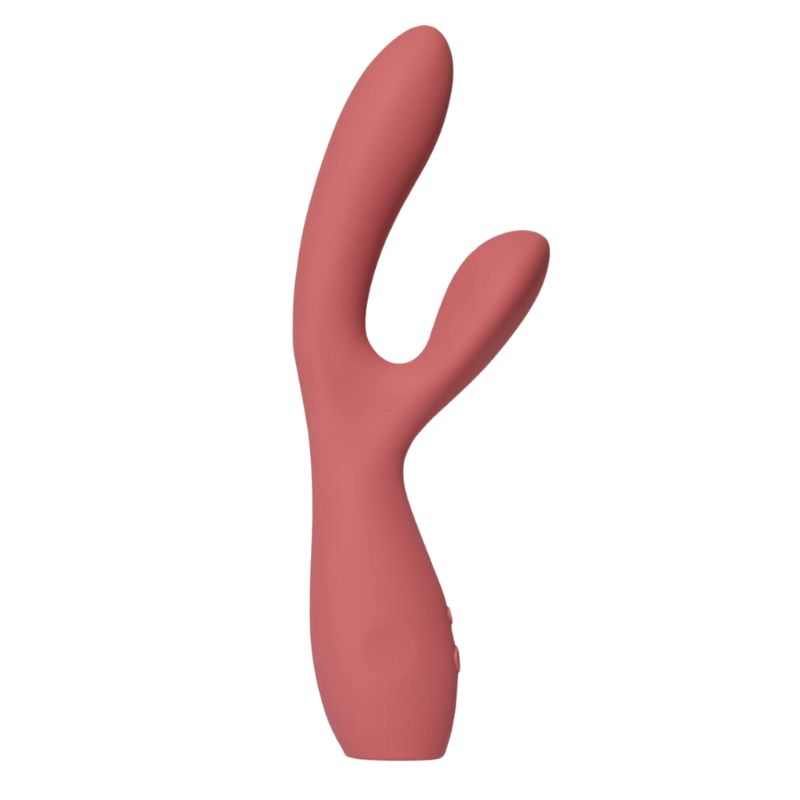What is edging? How to do it and the benefits of the pleasure-boosting practice
What is edging? This practice can help you slow things down for the better - here sex therapists and sexologists reveal how to do it


If orgasms don't come easily to you or you're looking to know how to have a better, longer-lasting one, edging could be the practice for you.
Far from being a social media sex trend as many of the best sex positions often are, edging is an orgasm-control technique sex therapists and coaches use with individuals and couples alike to help them have better sex.
"Edging is the technique used to prolong and control orgasm by maintaining a high level of sexual arousal, without reaching the point of orgasm for some time," says Kate Moyle, a psychosexual therapist. The idea behind doing so is that edging can help you slow down, reconnect with yourself, and find out what you actually like - and hopefully, have a better orgasm because of it. Here, experts reveal how to try it for yourself and the benefits.
What is edging?
Edging is a technique used to prolong and control an orgasm, psychosexual therapist Kate Moyle says. "It often looks like going up to the point of orgasm, and then slowing down or reducing stimulation before building it back up again," she explains.
It's a practice that can be done by yourself with masturbation techniques or with a partner - and there's no specific technique to it. "It's about maintaining a high level of sexual arousal without reaching the point of orgasm, which can then build up more intense anticipation, pleasure, and arousal," says Moyle, who is also the resident sex and relationship expert at Lelo. "And for some, it can make orgasms feel more intense when they finally happen."
How to do it
Edging is all about enjoying the waves of sexual stimulation rather than rushing to the 'finish' line, as many people do when masturbating and during partnered sex. To try edging for yourself, follow this simple pattern:
- Start sexual stimulation
- Change the intensity or stop it just before orgasm
- When arousal has become less intense, start to increase the intensity again
- Repeat the cycle
There's no specific time when you should stop edging - rather you should check in with yourself or your partner as to when the practice ends and you have the orgasm.
Sign up for the woman&home newsletter
Sign up to our free daily email for the latest royal and entertainment news, interesting opinion, expert advice on styling and beauty trends, and no-nonsense guides to the health and wellness questions you want answered.
That being said, if you are looking to try edging for the first time, the experts have some tips:
Make time and space for yourself
Trying anything new in the bedroom, whether alone or with a partner, takes patience so make sure you're in the right headspace. "Make sure you eliminate all distractions and really take the time to be with yourself," says BIPOC sexologist Marla Renee Stewart, who is also the sexpert for sexual wellness brand Lovers.
Stick to what you know at the beginning
When trying edging for the first time, it's a good idea to stick to what works. Then, when you're more au faux with the practice, you can move on to any new sex positions or techniques you want to try.
"Whether it's your hand or a sex toy, make sure that you have something that you use usually with masturbation to get you to orgasm. That way, you are familiar and you know what it takes to get you to orgasm," says Stewart.
If you're trying it with a partner, opt for sex positions you know and love - but if they're too good, you might struggle to lower the intensity when you need to. Positions that allow both partners to control any thrusting movements are a good idea too, such as the spooning sex position or the yab yum.
Practice mindfulness to avoid the 'point of no return'
The 'point of no return' is when orgasm is inevitable and trying to stop it from happening may dampen the experience. It's this point you want to come close to, before bringing yourself back down, the experts say.
To do this, Annabelle Knight, a couple’s counsellor and psychosexual therapist, recommends trying a form of sexual mindfulness. "This means paying attention to your body and living in the moment. Note how you feel at each stage, appreciate the pleasure, and be attentive to your body's signals. This will allow you to identify the point just before the orgasm becomes inevitable."
On approaching the 'point of no return', many people find their breathing becomes sharper or they hold their breath. Movements are simple and it can feel like all your attention has become focused on your genitals. That's when you need to stop and bring down the intensity, perhaps resting for a minute or two.
Don't try it the same way every time
That's the great thing about edging - there's not one set way to do it, so you can try different methods and test out what works for you (and your partner). "Like anything in our sex lives, curiosity is a big factor and without it, we can easily get stuck doing the same thing on repeat, which can have a dampening effect on desire. Mix up how you try edging with different types of touch, play, using your best vibrator or lube and don't focus on the amount of time it takes, more how you and/or your partner is responding," says Moyle.
"Often when we find something that works for us we tend not to want to break away from it, but getting stuck in sexual routines can have the opposite effect of it no longer working for us," she says.

Having a pick of the best bullet vibrators on hand when you try edging can help you monitor the intensity of stimulation with ease - especially if you're trying the technique by yourself. Tracey Cox Supersex Powerful Rechargeable Bullet Vibrator is made from liquid silicone wrapped in a smooth silicone casing, moulding to the skin for ultimate comfort. There are three speeds and seven vibration settings to choose from. Now in the Lovehoney sale!

The Artist is one of the best rabbit vibrators money can buy - and the nine pulsation modes, squeeze sensor, and super smooth silicone material make it so. It's a good choice for edging as the squeeze sensor means you can dial up and dial back the intensity with a squeeze of your fingers when you need to, without touching any of the buttons.

This app-controlled silicone ring has a tiny bullet vibrator wrapped up in the top, making it the perfect toy for couples looking to try edging. A simple button on the app turns controls the settings so you can dial up and slow down the stimulation intensity for the two of you as you please. While it might take a moment to be in the same place, it increases the chance of a simultaneous orgasm at the end.
What are the benefits of edging?
1. It can make your orgasm feel more intense
Many people who try edging find that staying in a heightened state of arousal for a longer time before orgasm makes their orgasm feel more intense when they finally have it - and it can help you learn how to have a better orgasm too.
"It can be a great technique for those who want to spend a bit more time on a sexual experience - something that many people struggle with in our very busy modern lives, and more focus on our pleasure without distraction is a real boost for our sex lives, and desire," says Moyle.
2. It can slow down how quickly you orgasm
If you find that you (or your partner) tend to orgasm a little too quickly, practising edging can be a great way to slow it down and help you build up some endurance. "It can help you gain better control over your sexual responses, which can be particularly beneficial for those looking to prolong sexual encounters," says Knight.
3. It can help you bond with your partner
Looking to learn how to have better sex? Edging could be the answer. It can help to bring the two of you together for longer, enhancing your emotional and physical connection.
"It offers a chance for you to get more comfortable with sexual communication and offering each other prompts during sex," Moyle says. "So often in our sex lives, we fear 'getting it wrong' and the best way to counteract that is to understand what's feeling good or not for our partners as sex is subjective."
Not only that - if you haven't had sex in a while, edging can be a good way to get back into the swing of things. "It's very approachable, easy to try, and adaptable depending on your preferences," says Angie Rowntree, the founder and director of award-winning site Sssh.com.

You can trying edging by yourself or with a partner.
4. Edging can help you reconnect with yourself
There are times in life when our sexual preferences, what we enjoy, and what feels comfortable tend to change - during and after menopause, for example. Edging can help you better know yourself and what you enjoy.
"You gain more self-awareness about your body and what it takes you to get closer to orgasm," says Stewart. "This can help you communicate with lovers, as you know which strokes might get you over the edge as needed with lovers."
5. Edging may help to ease sexual anxiety
Edging is truly the best practice for anyone who wants to take things slow, anyone unsure of what works for them, or anyone feeling some sexual anxiety.
If that anxiety manifests in feeling distant or distracted during sex, edging may be able to help. "Feeling distracted during sex can take away from pleasure and sexual satisfaction. Edging can help us to direct our attention towards what's happening in our bodies and give our pleasure our full focus," says Moyle.
As there's no formula to edging, you can keep going for as long as you like. However, Moyle warns against thinking that longer equals better. "If you're doing it with your partner go with the Emily Nagoski (leading sex educator and the author of Come As You Are) approach of 'pleasure is the measure'," she says. "Edging isn't an endurance test of how long you can last or maintain for, and it's not a challenge to be beaten. Communicate with each other about how it feels, and focus on what you're enjoying."
"It's not about making orgasm the goal of sex either which can create pressure and sometimes distraction, ironically focusing on our orgasm more can interrupt our ability to reach it."

Grace Walsh is woman&home's Health Channel Editor, working across the areas of fitness, nutrition, sleep, mental health, relationships, and sex. She is also a qualified fitness instructor. In 2025, she will be taking on her third marathon in Brighton, completing her first ultra marathon, and qualifying as a certified personal trainer and nutrition coach.
A digital journalist with over seven years experience as a writer and editor for UK publications, Grace has covered (almost) everything in the world of health and wellbeing with bylines in Cosmopolitan, Red, The i Paper, GoodtoKnow, and more.
-
 Dr Amir Khan reveals the 5 symptoms you should 'never' ignore, no matter how 'vague' they are
Dr Amir Khan reveals the 5 symptoms you should 'never' ignore, no matter how 'vague' they areDr Amir Khan, a GP who often appears on ITV's Lorraine, took to Instagram this week to share the symptoms he'll always take a second look at
By Grace Walsh
-
 Head to Hobbs for holiday-ready linen and the most elegant summer dresses you’ll find on the high street
Head to Hobbs for holiday-ready linen and the most elegant summer dresses you’ll find on the high streetWondering where to shop for a chic summer wardrobe? Hobbs has you covered
By Caroline Parr